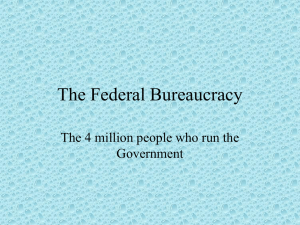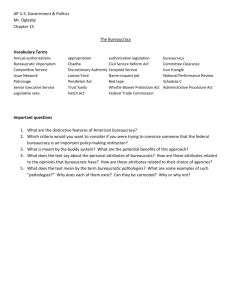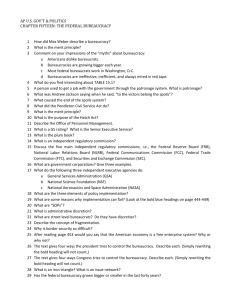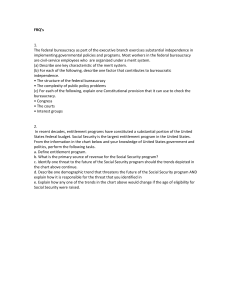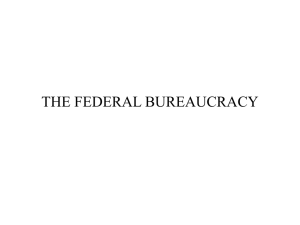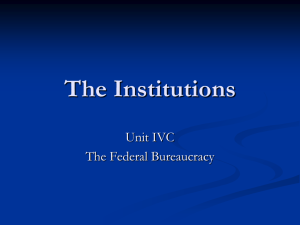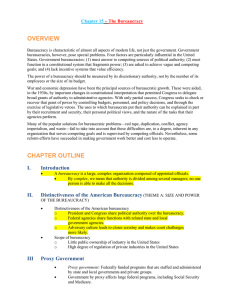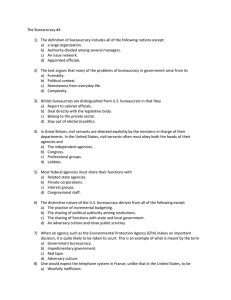The Bureaucracy - Resource Sites - List
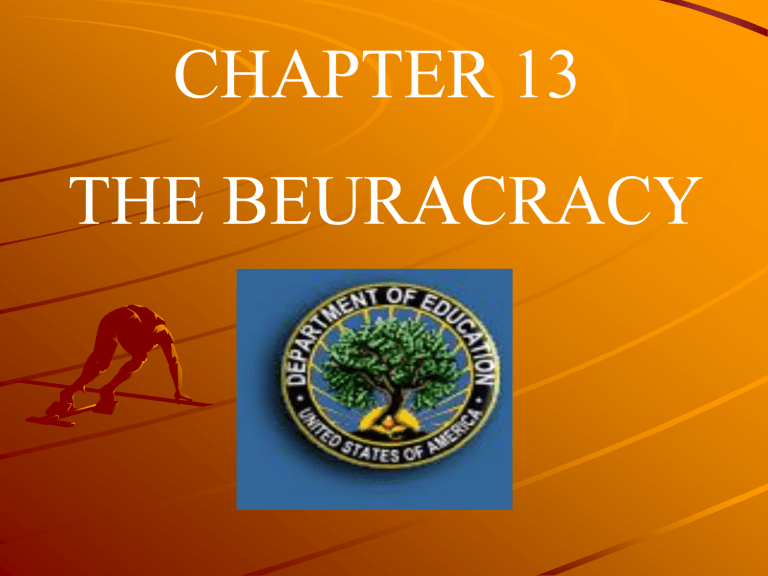
CHAPTER 13
THE BEURACRACY
In this chapter both the distinctiveness and the size of the federal government bureaucracy will be reviewed.
Federal Bureaucracy
Technically Part of the
Executive Branch of
Government - But Has
Two Masters – The
Executive and Legislative
Branch
The Growth of the Bureaucracy
– The early controversies
Senate consent to removal of officials is challenged by supporters of a strong president
President is given sole removal power but
Congress funds and investigates
– The appointment of officials
Officials affect how laws are interpreted, the tone of their administration, and their effectiveness
Use of patronage in the nineteenth and early twentieth centuries to reward supporters
The Growth of the Bureaucracy
– A service role
1861-1901: shift in role from regulation to service
Reflects desire for limited government, laissezfaire beliefs, and the Constitution's silence
– A change in role
Depression and World War II lead to a role of government activism
Introduction of heavy income taxes supports a large bureaucracy
THEME A - Size and Power of the
Bureaucracy
THE FEDERAL BUREAUCRACY
TODAY
Characteristics of Federal Civilian
Employees
Federal Government: Money, People and Regulations
Figure 13.1: The Real
“Washington” Bureaucracy
Source: Paul C. Light, The True Size of Government (Washington, D.C.: Brooking Institution, 1999). Data for 1996.
Direct and indirect growth
Modest increase in the number of government employees
Indirect increase through the use of private contractors much greater
Growth in discretionary authority
Delegation of undefined authority by Congress
Primary areas of delegation
– Subsidies to groups
– Grant-in-aid programs
– Enforcement of regulations
THEME B - Control of the
Bureaucracy
1. How they are recruited and rewarded.
2. Personal Attributes
3. The Nature of the Job
4. External forces
Pendleton Act (1883):
Transferred basis of government jobs from patronage to merit
Merit system protects president from pressure and protects patronage appointees from new presidents
Hatch Act (1939)
Prohibited federal workers from running for office or actively campaigning for other candidates .
Recruitment and retention
– The competitive service: most bureaucrats compete for jobs through OPM - Appointment by merit based on a written exam
– The excepted service: most are appointed by other agencies on the basis of qualifications approved by OPM
Fastest growing sector of federal government employment
Examples: Postal Service employees and FBI agents
Recruitment and retention
The buddy system
Name-request job: filled by a person whom an agency has already identified for middle- and upper-level jobs
Job description may be tailored for person
Circumvents usual search process
But also encourages "issue networks" based on shared policy views
Firing a bureaucrat
Most bureaucrats cannot be fired
Exception: Senior Executive
Service (SES)
SES managers receive cash bonuses for good performance
But very few SES members have been fired or even transferred
The agencies' point of view
Agencies are dominated by lifetime bureaucrats who have worked for no other agency
System assures continuity and expertise
But also gives subordinates power over new bosses: can work behind boss's back through sabotage, delaying, and so on
Constraints
– General constraints
Administrative Procedure Act (1946)
Freedom of Information Act (1966)
National Environmental Policy Act (1969)
Privacy Act (1974)
Open Meeting Law (1976)
– Effects of constraints
Government moves slowly
Government acts inconsistently
Easier to block than to take action
Reluctant decision making by lower-ranking employees
Why so many constraints
–Constraints come from us
–They are an agency's response to our demands for openness, honesty, fairness, and so on
Agency Allies
–Agencies often seek alliances with congressional committees or interest groups: "iron triangle"
–Far less common today; politics has become too complicated
More interest groups, more congressional subcommittees, and easier access for individuals
–"Issue networks": groups that regularly debate government policy on certain issues
Congressional oversight
Approval necessary for creation
Statutes influence agency behavior
(sometimes precisely)
Authorization of money, either permanent or fixed number of years
The legislative veto
A requirement that an executive action must lie before Congress for a specified period (usually
30 to 90 days) before it takes effect. Congress can pass a resolution of disapproval.
In June 1983, Court declares legislative veto to be unconstitutional in Chadha case.
Weakens traditional legislative oversight but
Congress continues creating such vetoes
National Performance Review
(NPR)
1993 - designed to reinvent government
–Differs from previous reforms in that it used the employees themselves
–Emphasizes customer satisfaction by bringing citizens in contact with agencies
NPR calls for innovation and quality consciousness by
–Less-centralized management
–More employee initiatives
–Customer satisfaction
Theme C: Bureaucratic
"pathologies”
– Red tape--complex and sometimes conflicting rules among agencies
– Conflict--agencies work at cross-purposes
– Duplication--two or more agencies seem to do the same thing
– Imperialism--tendency of agencies to grow, irrespective of benefits and costs of programs
– Waste--spending more than is necessary to buy some product or service
DEMOCRACY REQUIRES
Plurality, Equality, Liberty,
Rotation in office, Openness,
Equal access to participation in politics, Election
BUREAUCRACY
REQUIRES
Unity, Hierarchy, Command,
Duration in Office, Secrecy,
Differentiated access, based on authority, Appointment
For more information about this topic, link to the Metropolitan
Community College Political
Science Web Site http:// socsci.mccneb.edu/pos/polsc main.htm
